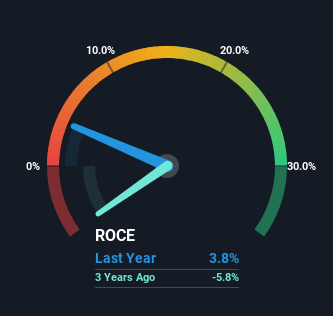- India
- /
- Hospitality
- /
- NSEI:CCHHL
We Like These Underlying Return On Capital Trends At Country Club Hospitality & Holidays (NSE:CCHHL)

If you're looking for a multi-bagger, there's a few things to keep an eye out for. Firstly, we'd want to identify a growing return on capital employed (ROCE) and then alongside that, an ever-increasing base of capital employed. If you see this, it typically means it's a company with a great business model and plenty of profitable reinvestment opportunities. Speaking of which, we noticed some great changes in Country Club Hospitality & Holidays' (NSE:CCHHL) returns on capital, so let's have a look.
What Is Return On Capital Employed (ROCE)?
Just to clarify if you're unsure, ROCE is a metric for evaluating how much pre-tax income (in percentage terms) a company earns on the capital invested in its business. Analysts use this formula to calculate it for Country Club Hospitality & Holidays:
Return on Capital Employed = Earnings Before Interest and Tax (EBIT) ÷ (Total Assets - Current Liabilities)
0.038 = ₹200m ÷ (₹6.6b - ₹1.4b) (Based on the trailing twelve months to June 2023).
So, Country Club Hospitality & Holidays has an ROCE of 3.8%. Ultimately, that's a low return and it under-performs the Hospitality industry average of 9.5%.
View our latest analysis for Country Club Hospitality & Holidays

While the past is not representative of the future, it can be helpful to know how a company has performed historically, which is why we have this chart above. If you want to delve into the historical earnings, revenue and cash flow of Country Club Hospitality & Holidays, check out these free graphs here.
What Can We Tell From Country Club Hospitality & Holidays' ROCE Trend?
Even though ROCE is still low in absolute terms, it's good to see it's heading in the right direction. We found that the returns on capital employed over the last five years have risen by 2,539%. The company is now earning ₹0.04 per dollar of capital employed. Speaking of capital employed, the company is actually utilizing 65% less than it was five years ago, which can be indicative of a business that's improving its efficiency. A business that's shrinking its asset base like this isn't usually typical of a soon to be multi-bagger company.
For the record though, there was a noticeable increase in the company's current liabilities over the period, so we would attribute some of the ROCE growth to that. The current liabilities has increased to 22% of total assets, so the business is now more funded by the likes of its suppliers or short-term creditors. It's worth keeping an eye on this because as the percentage of current liabilities to total assets increases, some aspects of risk also increase.
Our Take On Country Club Hospitality & Holidays' ROCE
From what we've seen above, Country Club Hospitality & Holidays has managed to increase it's returns on capital all the while reducing it's capital base. Investors may not be impressed by the favorable underlying trends yet because over the last five years the stock has only returned 23% to shareholders. So with that in mind, we think the stock deserves further research.
One final note, you should learn about the 3 warning signs we've spotted with Country Club Hospitality & Holidays (including 1 which shouldn't be ignored) .
If you want to search for solid companies with great earnings, check out this free list of companies with good balance sheets and impressive returns on equity.
New: AI Stock Screener & Alerts
Our new AI Stock Screener scans the market every day to uncover opportunities.
• Dividend Powerhouses (3%+ Yield)
• Undervalued Small Caps with Insider Buying
• High growth Tech and AI Companies
Or build your own from over 50 metrics.
Have feedback on this article? Concerned about the content? Get in touch with us directly. Alternatively, email editorial-team (at) simplywallst.com.
This article by Simply Wall St is general in nature. We provide commentary based on historical data and analyst forecasts only using an unbiased methodology and our articles are not intended to be financial advice. It does not constitute a recommendation to buy or sell any stock, and does not take account of your objectives, or your financial situation. We aim to bring you long-term focused analysis driven by fundamental data. Note that our analysis may not factor in the latest price-sensitive company announcements or qualitative material. Simply Wall St has no position in any stocks mentioned.
About NSEI:CCHHL
Country Club Hospitality & Holidays
Provides leisure hospitality membership services in India and the Middle East.
Low and slightly overvalued.


